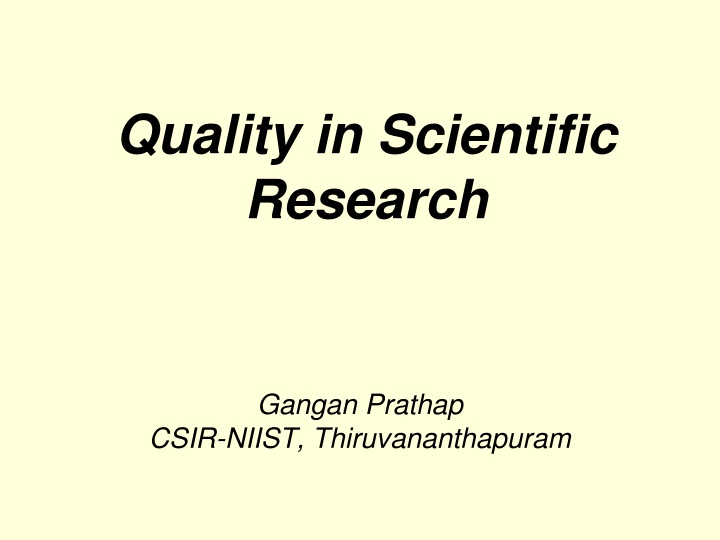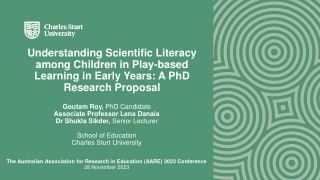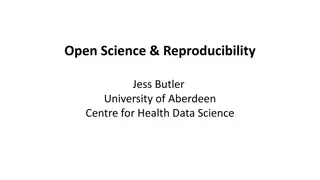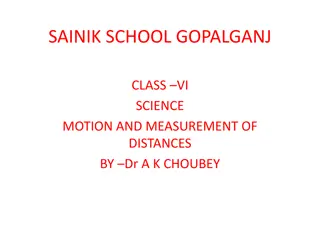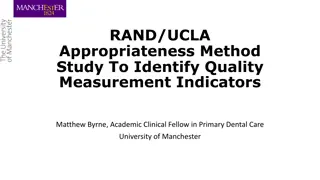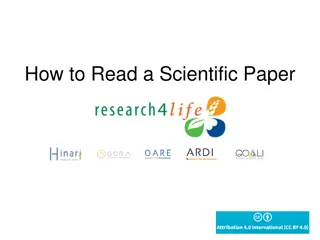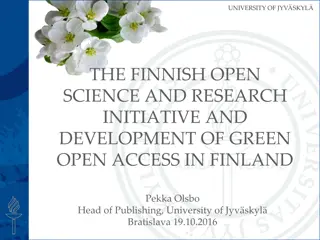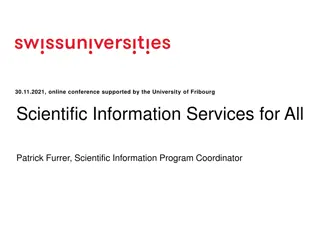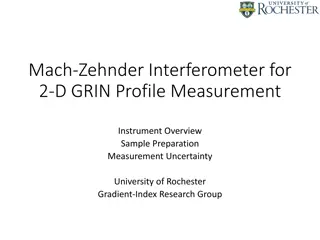Quality in Scientific Research: Understanding Science and Measurement
Importance of science in societal progress, history of science measurement, role of Gross Expenditures on Research and Development (GERD), and the limitation of manpower in research and development activities. It also touches upon the concept of excellence and the significance of quality over quantity in life.
Download Presentation

Please find below an Image/Link to download the presentation.
The content on the website is provided AS IS for your information and personal use only. It may not be sold, licensed, or shared on other websites without obtaining consent from the author.If you encounter any issues during the download, it is possible that the publisher has removed the file from their server.
You are allowed to download the files provided on this website for personal or commercial use, subject to the condition that they are used lawfully. All files are the property of their respective owners.
The content on the website is provided AS IS for your information and personal use only. It may not be sold, licensed, or shared on other websites without obtaining consent from the author.
E N D
Presentation Transcript
Quality in Scientific Research Gangan Prathap CSIR-NIIST, Thiruvananthapuram
Science as a source of progress During the 18th century, scientists convinced governments to finance their work: 1) science inculcates intellectual virtues like objectivity, logic and rationality in individuals 2) science drives socio-economic progress Also, universities have for many centuries (Bologna 1088, Oxford 1096) been autonomous institutions, committed to teaching and research. Outline for a History of Science Measurement, Beno t Godin
GERD? J. D. Bernal was the first to perform a measurement of science in a Western country. In The Social Function of Science (1939), Bernal estimated the money devoted to science in the United Kingdom using existing sources of data: government budgets, industrial data (from the Association of Scientific Workers) and University Grants Committee reports. He was also the first to suggest a type of measurement that became the main indicator of science and technology: Gross Expenditures on Research and Development (GERD) as a percentage of GDP. He compared the UK s performance (0.1%) with that of the United States (0.6%) and USSR (0.8%) and suggested that Britain should devote (0.5-1.0%) of its national income to research.
FTERs? The ceiling on research and development activities is fixed by the availability of trained personnel, rather than by the amounts of money available. The limiting resource at the moment is manpower . US science adviser J.R. Steelman, in 1947
Can excellence? we measure
Origin of EXCEL Middle English excellen, from Latin excellere, from ex- + -cellere to rise, project; akin to Latin collis hill more at hill First Known Use: 15th century http://www.merriam-webster.com/styles/default/images/interface/mwol2010_mw_logo_header.gif
Measurement: Assignment of numbers to objects or processes Theory of measurement?
Life is not about quantity. It is about quality. Socrates said over 30 years ago
"And what is good, Phaedrus, And what is not good - Need we ask anyone to tell us these things?" is the Socratic (and Platonic) wisdom 2300 years ago http://www.moq.org/forum/Prathap/prathap1.html
Quantity has a quality all of its own. Stalin
First quantity, then quality. Deng Xiaoping
The assessment of Indian science
Top 30 in All Fields 2002-2012 GDP wise quality indicator Zeroth order indicator First order indicator Second order indicator Rank Citations Per Paper Country 16.66USA Country SWITZERLAND PapersCountry 3199249USA CitationsCountry 50208701USA X 787970444 1 PEOPLES R CHINA DENMARK USA NETHERLANDS 15.73 15.69GERMANY 996935GERMANY 831676ENGLAND 11038202ENGLAND 11001142GERMANY 164455081 146501647 2 3 15.63JAPAN 15.61ENGLAND 793163JAPAN 735916FRANCE PEOPLES R CHINA 8188434FRANCE 7354022JAPAN 91103126 84535526 4 5 SCOTLAND ENGLAND 14.95FRANCE 593631 6420348CANADA NETHERLANDS 84511364 6 SWEDEN BELGIUM 14.75CANADA 13.91ITALY 485580CANADA 462968ITALY NETHERLANDS 6406015 5534428ITALY 66465443 66159850 7 8 FINLAND GERMANY CANADA 13.50SPAIN 13.27AUSTRALIA 13.19INDIA 375263 332527AUSTRALIA 327924SPAIN 4252011SWITZERLAND 3976977AUSTRALIA 3960297SPAIN PEOPLES R CHINA 2773025SWEDEN 2311340BELGIUM 2077628SCOTLAND 1994057DENMARK 1794156ISRAEL 1658499AUSTRIA 1533297FINLAND 1457925SOUTH KOREA 1441074NORWAY 1340896INDIA 1337782TAIWAN 1265994BRAZIL 1127867SINGAPORE 54722857 47564096 41794561 9 10 11 AUSTRIA NORWAY ISRAEL FRANCE AUSTRALIA ITALY NEW ZEALAND SPAIN JAPAN SINGAPORE GREECE SOUTH KOREA TAIWAN POLAND PEOPLES R CHINA BRAZIL INDIA TURKEY RUSSIA 13.02SOUTH KOREA 12.64NETHERLANDS 12.56RUSSIA 12.39BRAZIL 11.96TAIWAN 11.95SWITZERLAND 10.99SWEDEN 10.55TURKEY 10.32POLAND 10.22BELGIUM 9.12ISRAEL 7.26SCOTLAND 7.24DENMARK 6.75AUSTRIA 318539SWITZERLAND 272015SWEDEN 271611SOUTH KOREA 239055BELGIUM 199135INDIA 197062SCOTLAND 188006DENMARK 171883BRAZIL 167132ISRAEL 149383TAIWAN 116034AUSTRIA 114954RUSSIA 105467FINLAND 102985POLAND 3283869 41347599 40901182 28895779 28002468 26080375 18318297 17458873 17085514 16771236 12656411 12125564 10428575 9834556 7777696 12 13 14 15 16 17 18 19 20 21 22 23 24 25 26 27 28 29 30 6.44FINLAND 6.41GREECE 6.08NORWAY 5.51SINGAPORE 4.93NEW ZEALAND 93807NORWAY 90902TURKEY 79237GREECE 74396SINGAPORE 62536NEW ZEALAND 1001427POLAND 946496GREECE 828875NEW ZEALAND 760677RUSSIA 687018TURKEY 7611253 7557961 7547552 6589058 5212003
R&D Personnel FTERs per million of population PhDs in Engg Annually USA 4628 8110 China 715 15073 India 119 1058 E C Subba Rao, CURRENT SCIENCE, VOL. 104, NO. 1, 10 JANUARY 2013
India Research Funding and Research Output: A Bibliometric Contribution to the US Federal Research Roadmap Loet Leydesdorff & Caroline Wagner
Science and Technology Indicators Footprint Papers /Million 1 0.8 US 0.6 0.4 GERD/ Capita EU- 15 India 0.2 0 Patents/ Million Million Patents/ FTERs/ Million
In the present exercise, the scientific output measured in terms of articles published from the various states of India as registered by the Web of Science over a 3 year period (2007-2009) P, is taken as the output term. The GDP of each state, in billions of dollar in 2009 ($Bn) is taken as the proxy for the input term (http://www.economist.com/content/indian- summary accessed on 22 July 2011).
quality of scientific activity, the ratio of Output to Input, q = P/$Bn. This indicator usually favours small states at the expense of larger states where the law of diminishing returns sets in. Indeed, there will always be cases of high input but low output and therefore low quality, or low input and medium output but of high quality, etc. It is therefore desirable to assess overall performance in terms of a single indicator. output or outcome (O), an input of size Q, to combine quality q with quantity Q and/or output O to yield a single indicator that is the best proxy for performance.
given an input (for quantity) Q output or outcome (for quasity), O quality, is defined as quasity/quantity q = O/Q indicator for performance becomes X = qO = q2Q.
Q = $Bn (billion dollars of GDP), and O = P (papers published during 2007- 2009). q = P/$Bn X = P2/$Bn. X is a product of the quality and the quasity term and perhaps performance of each state on a per GDP basis. best represents the
State Tamil Nadu Maharashtra Uttar Pradesh Karnataka West Bengal Delhi Andhra Pradesh Kerala Gujarat Madhya Pradesh Punjab Rajasthan Chandigarh Haryana Assam Orissa Uttarakhand Himachal Pradesh Bihar Jammu & Kashmir Pondicherry Jharkhand Goa Meghalaya Chhattisgarh Arunachal Pradesh Manipur Sikkim Tripura Mizoram Andaman & Nicobar Islands Nagaland Lakshadweep Total Number of Papers P 17507 16577 15843 15156 14471 14157 9494 4559 4094 3835 3151 2814 2640 2555 2210 2105 1223 1137 1019 988 875 698 626 364 238 195 156 124 TABLE I TAMIL RANKED FIRST ON THE BASIS OF THE NUMBER OF PAPERS PUBLISHED 2007-09. NADU IS DURING 96 84 77 68 Kerala ranks 8th in India in raw output 2 125619
TABLE II GDP $Billion q = P/$Bn 643.90 392.16 312.50 240.95 218.84 206.67 195.00 188.18 173.33 Exergy X = P x P/$Bn 1699902.44 5551818.53 States/UTs Chandigarh Delhi Puducherry Karnataka Tamil Nadu Sikkim Arunachal Pradesh West Bengal Meghalaya 4.1 36.1 2.8 62.9 80 0.6 ON A QUALITY BASIS (PAPERS PER BILLION DOLLARS OF GDP), CHANDIGARH RANKS FIRST. 273437.50 3651897.23 3831188.11 25626.67 38025.00 2723144.88 63093.33 1 76.9 2.1 Andaman & Nicobar Islands Uttar Pradesh Goa Jammu & Kashmir Himachal Pradesh Uttarakhand Assam India Manipur Andhra Pradesh Kerala Mizoram Madhya Pradesh Maharashtra Punjab Orissa Rajasthan Haryana Gujarat Nagaland Jharkhand Tripura Bihar Chhattisgarh Lakshadweep 0.5 154.00 153.07 149.05 130.00 127.75 123.54 118.82 116.12 111.43 110.78 110.66 105.00 102.82 94.56 77.80 66.19 60.78 57.81 51.11 45.33 39.89 36.92 31.16 10.48 6.67 11858.00 2425127.04 93303.81 128440.00 145254.94 151083.74 262586.02 14586922.87 17382.86 1051762.38 504477.69 8820.00 394295.58 1567580.88 245155.58 139340.41 171027.99 147692.87 209248.89 3082.67 27840.23 3544.62 31754.16 2495.33 103.5 4.2 7.6 8.9 9.9 18.6 1081.8 ON THE SECOND- ORDER INDICATOR BASIS, DELHI EMERGES FIRST. 1.4 85.7 41.2 0.8 37.3 175.3 40.5 31.8 46.3 44.2 80.1 1.5 17.5 2.6 32.7 22.7 0.3 Delhi contributes 38% of India s scientific output, while on GDP terms, it accounts for only 3.3% of India s GDP. Kerala ranks 19th in India in per GDP output 13.33
The assessment of Indian universities
In economic terms, India was the worlds largest economy in the first millennium, producing a third of global GDP. By 1500 its share had declined to 25 percent, as China overtook it and Western Europe s share began to expand rapidly. India s share continued to fall after 1700.
Higher Education in Europe Bologna in 1088 Bologna_University_seal 200px-Oxford_University_Logo Oxford in 1096 Europe adds 70 universities in 500 years i.e. 1 university/million population around 1500AD India and China? 0
India, Kerala and Scandinavia India Kerala Scandinavia Population 1238 million 33 million 26 million No of Univ in ARWU Top 500 1 0 24
Universities per million of population Population 2001 Census Delhi (UT) 13,850,507 Himachal Pradesh 6,077,900 Uttarakhand 8,489,349 Jammu & Kashmir 10,143,700 Tamil Nadu 62,405,679 Karnataka 52,850,562 Rajasthan 56,507,188 Maharashtra 96,878,627 Haryana 21,144,564 Punjab 24,358,999 Orissa 36,804,660 Madhya Pradesh 60,348,023 Andhra Pradesh 76,210,007 West Bengal 80,176,197 Kerala 31,841,374 Assam 26,655,528 Uttar Pradesh 166,197,921 All India 830,940,785 Uni/M of Pop Division Universities 17 1.23 1.15 1.06 0.89 0.66 0.51 0.44 0.43 0.43 0.41 0.41 0.35 0.33 0.32 0.28 0.26 0.25 0.41 7 9 9 41 27 25 42 9 10 15 21 25 26 9 7 41 340
Scimago Institutions Rankings (SIR 2014) Two output dimensions, quantity and quality. The quantity or size dimension is given simply by the number of articles published during the five-year window, normalized on the 0- 100 scale. We indicate this normalized quantity indicator by Output O. For this entire cycle from 2009 to 2014, the Centre National de la Recherche Scientifique (CNRS) of France was listed as the top ranking institution in the world with the score of 100. The second dimension is quality. SIR gives several field-normalized size-independent indicators which are in varying ways proxies for this but we shall restrict attention to only one Excellence Rate, which is the proportion (in %) of an institution s scientific output that is included into the set of the 10% of the most cited papers in their respective scientific fields and is a measure of high quality output of research institutions. Again, for each year, these values are normalized so that the highest ranking performer has a score of 100. We indicate this normalized quality indicator by q.
Scimago Institutions Rankings (SIR 2014) One size-dependent input indicator, the Scientific talent pool (STP) which is the total number of authors from an institution in the total publication output of that institution during a particular period of time as a meaningful measure of the input into research activities. This is also normalized in the same manner as above and again for the period from 2009 to 2014, CNRS of France was listed as the largest institution in the world with the score of 100.We indicate this normalized input indicator by STP.
For a single-valued composite outcome indicator, we computed the second-order indicator called the exergy term from the quantity and quality indicators, X = q2O. Productivity is then computed as X2/STP and this becomes a plausible performance indicator. Input STP Output O Excellence- Exc = q Outcome X = q2O Productivity X/STP.
The ranking of the seven HEIs from Kerala out of the 156 from India from SIR 2014 using the second-order outcome indicator X. Rank Higher Educational Institution X 1 Indian Institute of Science 2135.29 37 Amrita University 185.65 67 National Institute of Technology Calicut 94.62 68 Cochin University of Science and Technology 90.71 73 University of Kerala Sree Chitra Tirunal Institute for Medical Sciences and Technology 82.11 78 69.35 105 Mahatma Gandhi University 37.50 156 Kerala Veterinary and Animal Sciences University 0.16
Kerala, Slovenia and the University of Ljubljana The Republic of Slovenia, is a small nation state on the Adriatic Sea, bordering Italy to the west, Austria to the north, Croatia to the south and southeast, and Hungary to the northeast. It had a population of 2.06 million in 2013. It is therefore smaller than each of the nine most populous districts of Kerala (Malappuram with a population of 4.11 million according to the 2011 Census was the largest and Alappuzha with 2.13 million was the ninth largest district). Slovenia has one university in the ARWU Top 500, namely the University of Ljubljana. It is the oldest, the largest (61,000 students) and the best ranked university in Slovenia.
The seven HEIs from Kerala in SIR 2014 benchmarked against the University of Ljubljana for 2014 O/ST Benchmarking against U of Ljubljana for 2014 STP OUTPUT Excellence X P X/STP Amrita University 0.90 0.37 22.40 185.65 0.41 206.28 Cochin University of Science and Technology Kerala Veterinary and Animal Sciences University 0.86 0.68 11.55 90.71 0.79 105.48 0.48 0.18 0.94 0.16 0.38 0.33 Mahatma Gandhi University 0.37 0.26 12.01 37.50 0.70 101.36 National Institute of Technology Calicut Sree Chitra Tirunal Institute for Medical Sciences and Technology 0.35 0.27 18.72 94.62 0.77 270.34 0.57 0.42 12.85 69.35 0.74 121.67 University of Kerala 0.55 0.39 14.51 82.11 0.71 149.29 Kerala 7 4.08 2.57 14.76 560.11 0.63 137.28 University of Llubljana 4.71 5.55 20.07 2235.57 1.18 474.64
During the period 2004-2013, this single university published 18,445 publications according to the Web of Science Core Collection; that is more than all the instititutions in Kerala put together (15,519 records), and nearly twice as much as all higher educational institutions in Kerala (Kerala 7) taken together (9397 records). How do the seven HEIs from Kerala in SIR 2014 fare in comparison with the University of Ljubljana for the latest year in the SIR time series. We see that Ljubljana has a scientific talent pool that is comparable to Kerala 7, but an output productivity that is nearly twice and an outcome productivity that is nearly three and a half times as much.
Profile of a leading university* * Sowter, 2008
Profile of a leading university* compared with IISc <5000 students US$0m endowment <500 faculty US$50m annual budget ~100 years old * Sowter, 2008
